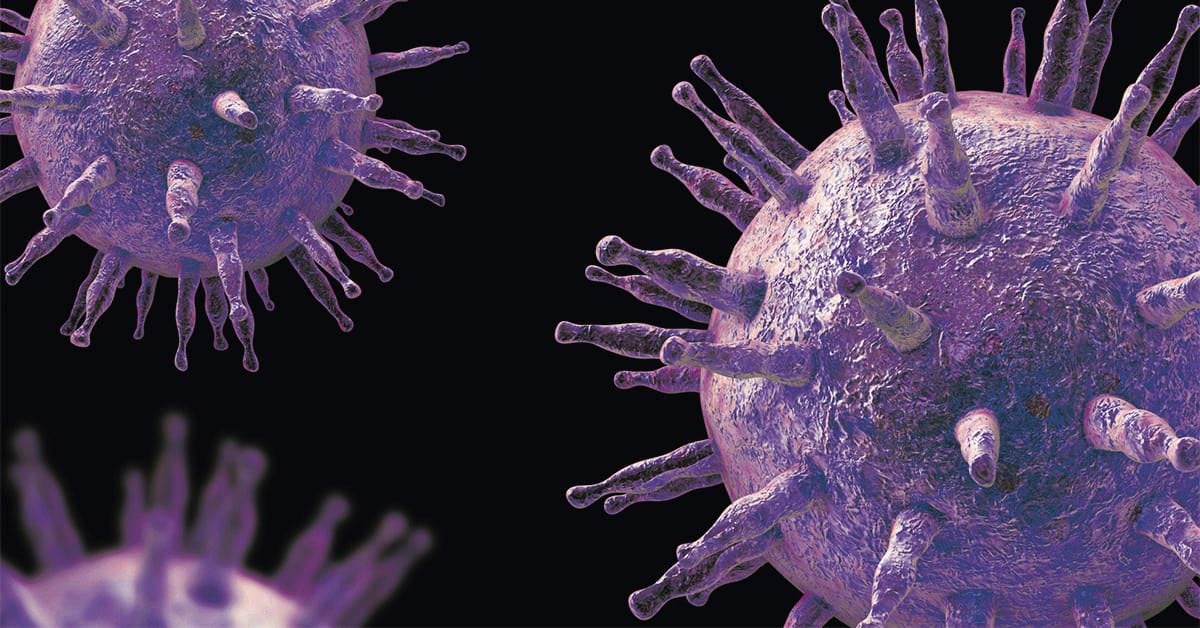
Exibição de arte representando o vírus Epstein-Barr, que infectou mais de 90% da população mundial. Pesquisadores descobriram como o vírus Epstein-Barr (EBV) explora vulnerabilidades genéticas para causar câncer, reduzindo a capacidade do corpo de suprimi-lo. O estudo revelou que a proteína viral EBNA1 se liga a um local frágil no cromossomo 11 humano, o que leva à quebra cromossômica e inicia uma cascata de instabilidade genética que pode ativar um oncogene causador de leucemia e desativar um dos principais supressores de tumor. Ao examinar os dados de sequenciamento do genoma completo, os cientistas descobriram que os tumores de câncer com EBV detectável apresentavam níveis mais altos de anormalidades do cromossomo 11. Crédito: Mobitec
Epstein Bar está em toda parte[{” attribute=””>virus targets “fragile DNA,” triggering dysfunction that is associated with a variety of cancers.
Researchers have discovered how the Epstein-Barr virus (EBV) exploits human genomic weaknesses to cause cancer and suppress the body’s defenses. The study shows that the EBNA1 viral protein binds to a fragile site on human chromosome 11, leading to chromosomal breakage and genomic instability that may result in cancer. This finding could help identify risk factors and develop preventative strategies for EBV-associated diseases.
The Epstein-Barr virus (EBV) is easily spread through bodily fluids, primarily saliva, such as kissing, shared drinks, or using the same eating utensils. Not surprisingly then, EBV is also among the most ubiquitous of viruses: More than 90% of the world’s population has been infected, usually during childhood.
EBV causes infectious mononucleosis and similar ailments, though often there are no symptoms. Most infections are mild and pass, but the virus persists in the body, becoming latent or inactive, sometimes reactivating. Long-term latent infections are associated with several chronic inflammatory conditions and multiple cancers.
In a new paper, published April 12, 2023, in the journal Nature, researchers at University of California San Diego, UC San Diego Moores Cancer Center, and Ludwig Cancer Research at UC San Diego, describe for the first time how the virus exploits genomic weaknesses to cause cancer while reducing the body’s ability to suppress it.
These findings show “how a virus can induce cleavage of human chromosome 11, initiating a cascade of genomic instability that can potentially activate a leukemia-causing oncogene and inactivate a major tumor suppressor,” said senior study author Don Cleveland, PhD, Distinguished Professor of Medicine, Neurosciences and Cellular and Molecular Medicine at UC San Diego School of Medicine.
“It’s the first demonstration of how cleavage of a ‘fragile DNA’ site can be selectively induced.”
Throughout every person’s genome or full set of genes are fragile sites, specific chromosomal regions more likely to produce mutations, breaks or gaps when replicating. Some are rare, some are common; all are associated with disorders and disease, sometimes heritable conditions, sometimes not, such as many cancers.
In the new study, Cleveland and colleagues focus on EBNA1, a viral protein that persists in cells infected with EBV. EBNA1 was previously known to bind at a specific genomic sequence in the EBV genome at the origin of replication. The researchers found that EBNA1 also binds a cluster of EBV-like sequences at a fragile site on human chromosome 11 where increasing abundance of the protein triggers chromosomal breakage.
Other prior research has shown that EBNA1 inhibits p53, a gene that plays a key role in controlling cell division and cell death. It also suppresses tumor formation when normal. Mutations of p53, on the other hand, are linked to cancer cell growth.
When the scientists examined whole-genome sequencing data for 2,439 cancers across 38 tumor types from the Pan-Cancer Analysis of Whole Genomes project, they found that cancer tumors with detectable EBV revealed higher levels of chromosome 11 abnormalities, including 100% of the head and neck cancer cases.
“For a ubiquitous virus that is harmless for the majority of the human population, identifying at-risk individuals susceptible to the development of latent infection-associated diseases is still an ongoing effort,” said the study’s first author Julia Li, PhD, a postdoctoral fellow in Cleveland’s lab.
“This discovery suggests that susceptibility to EBNA1-induced fragmentation of chromosome 11 depends on the control of EBNA1 levels produced in latent infection, as well as the genetic variability in the number of EBV-like sequences present on chromosome 11 in each individual. Going forward, this knowledge paves the way for screening risk factors for the development of EBV-associated diseases. Moreover, blocking EBNA1 from binding at this cluster of sequences on chromosome 11 can be exploited to prevent the development of EBV-associated diseases.”
Reference: “Chromosomal fragile site breakage by EBV-encoded EBNA1 at clustered repeats” by Julia Su Zhou Li, Ammal Abbasi, Dong Hyun Kim, Scott M. Lippman, Ludmil B. Alexandrov and Don W. Cleveland, 12 April 2023, Nature.
DOI: 10.1038/s41586-023-05923-x
Co-authors include: Julia Su Zhou Li, Ludwig Cancer Research and UC San Diego; Ammal Abbasi, Scott M. Lippman and Ludmil B. Alexandrov, UC San Diego; and Dong Hyun Kim, Ludwig Cancer Research, UC San Diego.

“Criador. Viciado em mídia social que gosta de hipster. Fã da web. Fanático por álcool apaixonado.”











More Stories
A Boeing pode não conseguir operar o veículo Starliner antes que a estação espacial seja destruída
Vivendo com ansiedade: conselhos de especialistas sobre como aceitar um problema de saúde mental
Nova pesquisa sobre uma enorme falha de impulso sugere que o próximo grande terremoto pode ser iminente